When will the world reach “peak child”?

Hans Rosling famously coined the term ‘peak child’ for the moment in global demographic history at which the number of children in the world stops increasing.
In this post I look into the latest data – and various demographic projections – to ask when the world will reach ‘peak child’ and how the number of children in the world will evolve in the future.
From studying this question we can learn two things: First, it allows us to understand how the world’s population will continue to evolve.
Second, projections of the number of children in the world provide insights into the upper limit of demand for education in the future.1 If we want to understand the challenges for educating the world’s population of tomorrow, then we must have a good understanding of how the number of young children will evolve.
A quick preview of the results:
- The world has probably not reached ‘peak child’ yet. However, we are likely very close to a long flat peak; the number of children in the world will not increase much more. We are close to the peak.
- A key insight from projections, under different scenarios, is that the number of children in the long-run will depend on how successful the world will be in providing education – in particular to women – in the short-run. This is because women that are better educated tend to have fewer children. If we are successful in providing accessible education for all in the near-term, there will be fewer children – and therefore less demand for education – in the future.
- In the last part of this post I will discuss how the size of the population will change in different world regions. Crucial will be the African continent: fast development in Africa will slow down population growth, whereas slow development would leave African countries in an extended period of fast population growth. The latter scenario could see the African population growing 5-fold over the 21st century.
The last decades and the next decades
Between 1950 and today the world population tripled: from 2.5 billion to 7.5 billion. Over this period educational systems around the world had to provide education for substantially larger cohorts of children at school age. Since 1950 the total number of children younger than 15 years of age increased rapidly, from 0.87 billion children to 1.96 billion today. The world was largely successful in getting more children into school; while the number of children increased globally there were fewer and fewer out-of-school children. In the last two decades the number of out-of-school children has almost halved.
The future will be very different from the past. Over recent decades we have seen global demographic changes which will bring about the end of rapid population growth: Until the mid-1960s each woman around the world had on average 5 children. Since then the number of children has halved and is now just below 2.5 children per woman. The global fertility rate has halved.
Based on these demographic changes the UN Population Division makes projections of how the world population will change until the end of this century. The Medium Variant of this projection is shown in the visualization below and it shows that with respect to demographic changes the challenges for providing education in this century will be substantially smaller than in the last century. With a much lower global fertility rate, the increase in educational pressures will be much slower than the last 50 years. In fact the number of children will rise only very slowly and will barely increase at all over the coming century. The UN expects the number of children to peak in 2057 at 2.09 billion children and by the end of the century the number of children will be basically the same as today (just below 2 billion in the UN forecast).2
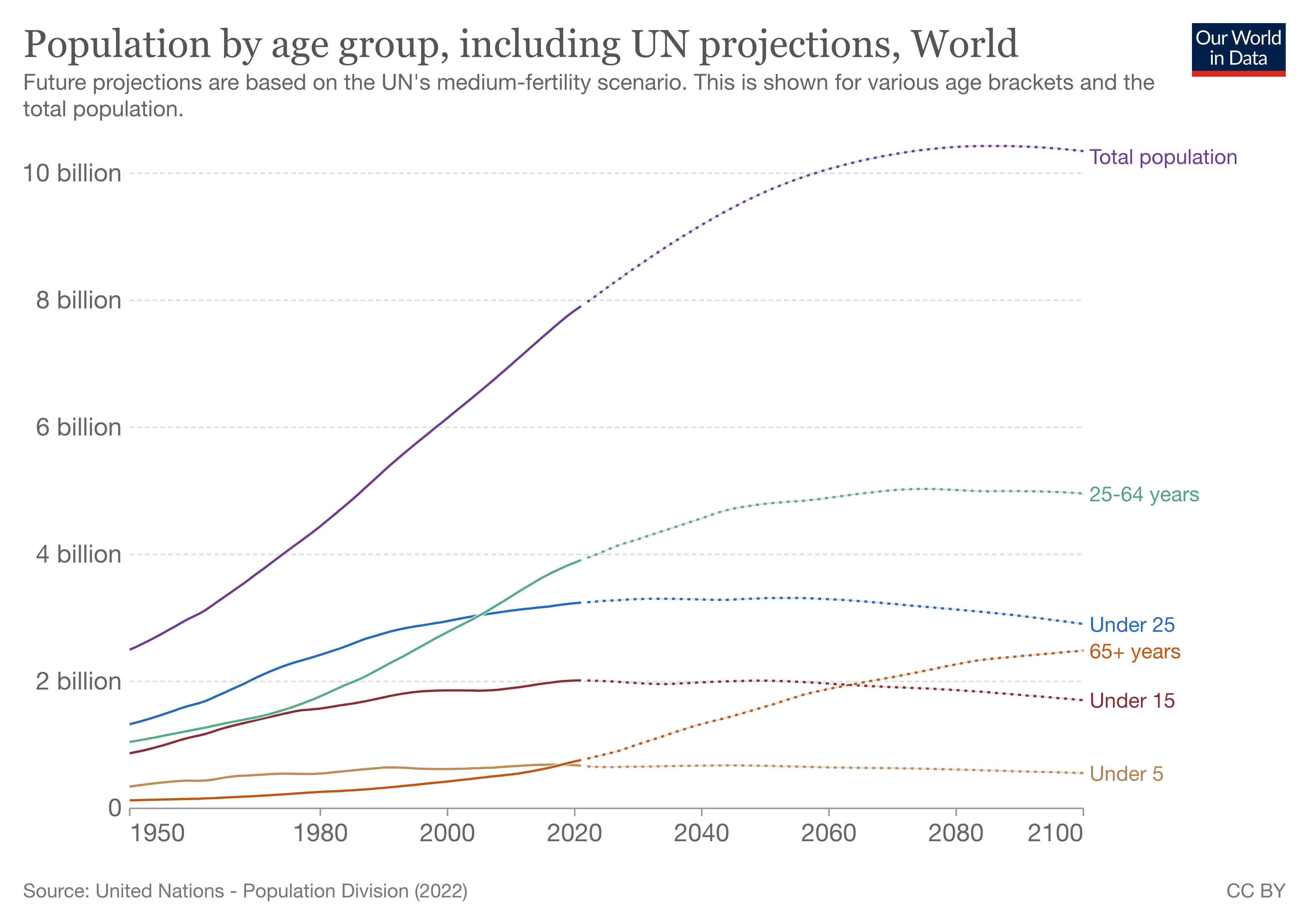
Since the middle of the 20th century the number of school-age-children increased by 125%. From today to the peak number of children, the number of children will only increase by 7%. If these projections are correct, then the world is not quite at ‘peak child’ yet, but we are approaching a flat plateau at which, over the course of the next 4 decades, we will gradually reach a very flat peak.3
While over the last decades the world’s educational systems were strained with the task of substantially increasing the quantity of education, from today until 2100 there will be little increase in the number of school-aged children. We can therefore focus our efforts instead on increasing the quality of education.
The link between education in the short-run and the size of the population in the long-run
Population growth is driven by three changes: Fertility, mortality, and migration. Until space travel becomes an option it is only the first two that matter at the global level.
Education matters for both mortality and fertility:
Education –> Mortality –> Fertility rates: The education of mothers is important for the health and mortality of children and there is a strong link between higher education of mothers and lower mortality of their children.4
A reduction of child mortality would of course directly increase the number of children. However, it is more complicated than that. In addition to this direct effect of fewer child deaths there is an important indirect effect: When fewer children die, families decide to have fewer children in the first place which results in a decline in fertility rates. This is an important part of the reason why population growth is low where the mortality of children is low.
Education –> Fertility rates: From demographic research we know that improving the education of women has been one of the most important drivers of the halving of the global fertility rate from 5 to 2.5 children per woman over the last 4 decades. Today, population growth is high where fertility remains high and fertility rates remain high where the education of women remains low.
In the entry on fertility rates we present the research that shows that this is not just a correlation; better education indeed causes a decline in the number of children per woman. This is the key mechanism at work here.
Education –> Population growth
Today it is the fertility rate that matters for population growth.5
One way to see that the fertility rate is key – and not child mortality – is to look at the correlation between the two measures. A second way to see this is to play out a scenario in which fertility rates would stay at their current level – the UN has such an illustrative scenario with constant fertility rates and in this scenario the world population would continue to grow extremely fast and reach a population of 26 billion(!) in the year 2100. The fertility rate is what matters for population growth and education therefore matters because it is a strong determinant of fertility rates.
The WC-IIASA projections: How investments in education matter for the global population in the 21st century
In this post I am focussing on two sets of projections: the UN projections – as they are the most widely discussed projections – and the projections published by IIASA and the Wittgenstein Centre, which I refer to as the WC-IIASA projections.6
Future projections of global population are uncertain. Much of the uncertainty comes from the fact that we do not know which investments the world will make in those systems that determine mortality and fertility – most importantly in education, as we have just explored.
The WC-IIASA projections differ from the work of the United Nations in a number of fundamental ways – see the footnote for more information.7 While the projections by WC-IIASA are less widely known than the UN projections, the WC-IIASA work is certainly very respected among demographers and key publications by the researchers are regularly published in the scientific journal Nature.8
Most importantly for our discussion here is that while other projections only structure demographic data by sex and age-group, the WC-IIASA data also breaks down the population data by the level of highest educational attainment. This information on educational attainment is then used for both the output of the model – so that population projections for each country of the world by highest educational attainment are available (on Our World in Data here). And crucially this information on education is also used as an input to the model so that the impact of different future scenarios for education on both mortality and fertility can be modeled explicitly.
The level of highest educational attainment is categorized in a system that aims to capture the structure of populations across the different country-specific educational systems – see the footnote for details.9
The four future scenarios for global education
The researchers developed 4 different basic scenarios to model the demographic structure of the global population:10
Constant Enrollment Numbers (CEN) scenario: This is the researcher’s most pessimistic scenario. Here it is assumed that in the future no more schools are opened in any place in the world, and so the absolute number of people reaching a particular educational level is frozen at the current level.11
Constant Enrollment Rates (CER) scenario: This is another pessimistic scenario. While in the CEN scenario the absolute number of enrolled students stagnates, the assumption in the CER scenario is that the rate of enrollment stagnates. In this scenario the most recently observed rates of educational enrollment are frozen at their current rate and no further improvement in enrollment is assumed.
This will still result in further improvements of adult education because in many countries the younger cohorts are better educated than the older ones. But in the longer run this scenario also implies stagnation.
Fast Track (FT) scenario: This scenario is the most optimistic one and here it is assumed that countries follow the most rapid education expansion achieved in recent history – that of South Korea.
Global Education Trend (GET) scenario: This is the middle scenario and here the researchers assume that countries will follow the average path of educational expansion that countries further advanced in this process have experienced.
In this scenario the researchers project the medium future trajectory based on the experience of all countries over the past 40 years
The researchers write: “The GET scenario is moderately optimistic, and can be considered as the most likely.”12
The size and structure of the world population under different educational scenarios
Now we can see how the size of the total world population and the educational achievements of this population will evolve under these four scenarios.
In this visualization we see that how fast education will become available in the short term will matter very substantially for the size of the world population in the longer-term – even for the evolution of world population over the next 5 decades.
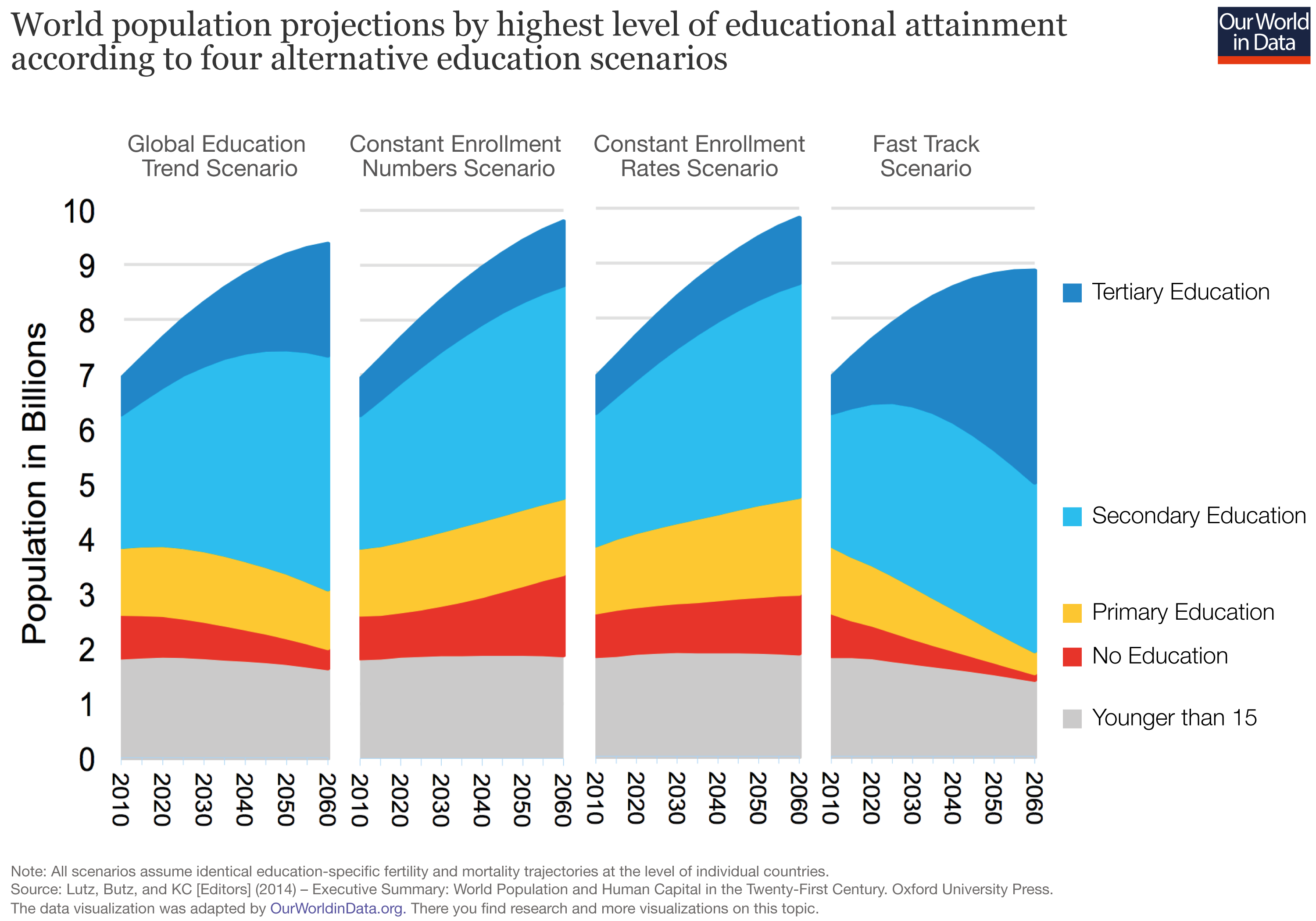
By 2060 the world population is projected to reach 9.8 billion under the Constant Enrollment Rates (CER) scenario, which is pessimistic about improvements in global education. If we assume optimistic progress in global education, as in the Fast Track (FT) scenario, then global population is projected to increase to only 8.9 billion. A difference of almost one billion – as early as 2060 – may therefore be solely driven by differences in progress on global education.
This finding – alternative education scenarios alone make a difference of one billion for the global population over such a short time-frame – is discussed in more detail in a publication in Science by Lutz and KC (2011).13
While the differences between the educational scenarios are slow to materialize and only show up after some decades,14 they are then very substantial and matter hugely for the size of the future world population. Whether or not the world is making fast progress in making education available to more children faster will matter for the size of the global population in just a few decades.
Global demand for education: The population of school-age children
And the size of the cohort of school children in turn, will of course matter how easy or hard it is to make education available for all. Let’s see how different possible scenarios in educational improvements matter for ‘peak child’ and the size of the population in school age.
For this we rely on scenarios of the WC-IIASA researchers which differ only in the assumptions on educational attainment.16
The visualization below shows the three projections of the size of the population of school-age-children until the end of this century:
- According to the projection of the pessimistic Constant Enrollment Scenario the population younger than 15 will evolve similarly to the Medium Variant projection of the UN: the number of children will continue to increase slowly and reach a plateau in the mid-21st century before the population will decline to a size similar to today’s population of under-15-year-olds.
- The medium projection of WC-IIASA – the projections they see as most likely – substantially differs from the UN’s Medium projection: In the most likely scenario – Global Education Trends (GET), which the WC-IIASA researchers see as a continuation of the recent educational trends – the size of the population younger than 15 will soon start to fall and at the end of the century the population of under-15-year-olds will be one-third smaller than today! According to this middle-of-the-road scenario by WC-IIASA the world is very close to ‘child peak’.
- Even faster will be the decline in the Fast Track scenario. If the world can achieve such a rapid expansion of education, then the size of the population of under-15-year-olds is projected to fall and decline to just one billion in 2100 (almost the same level as 1950).
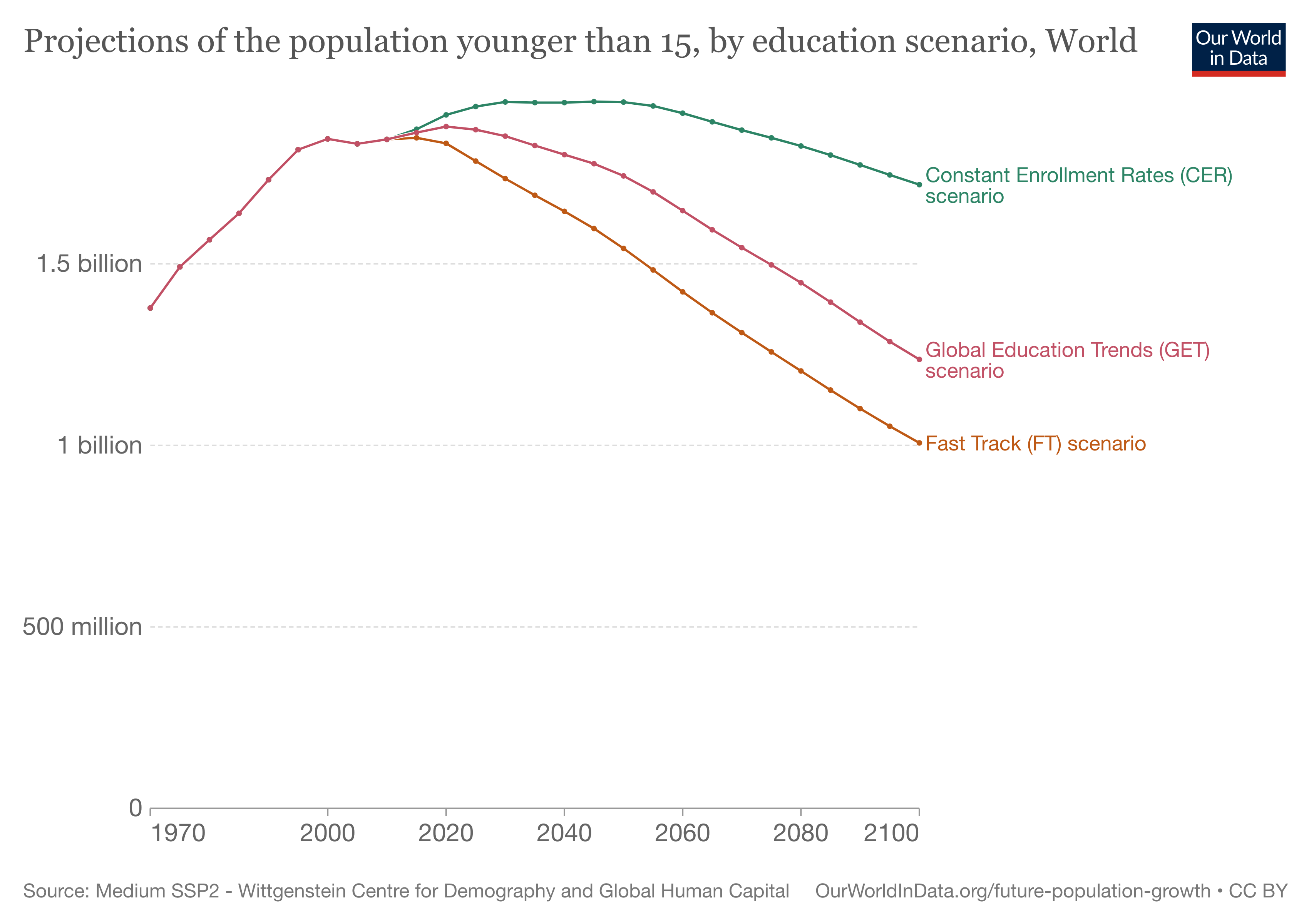
What this comparison of scenarios shows us is that the size of the global population younger than 15 – the upper bound for the global demand for education – will very much depend on how rapidly access to education can be extended.17
A larger increase in the educational attainment in the short-run will mean that the size of cohorts that need investments in the long-run will be much smaller: The difference between no further improvements in the educational enrollment (CER scenario) and a continuation of the successful last decades will mean that the global population of under-15-year-olds will be half a billion smaller at the end of the century. An acceleration to the Fast Track (FT) scenario would mean that this global figure is again smaller by yet another 200 million children.
Projections of the total population – UN vs IIASA-WC
So far we have looked at the total figures for the global population. What we have not yet taken into account is how the size of the population will evolve in different regions and countries of the world.
Total population: UN
The Medium Variant of the UN projections for all world regions until the end of this century is shown in this chart. Changes to the population size of the Americas, Oceania, and Europe are very small compared to the large expected changes in Asia and Africa. The UN expects the population of Africa to increase 3.5-fold – from 1.3 billion in 2019 to 4.5 billion by the end of the century. The population of Africa then will be as large as the population of Asia today, and the rate of this increase in the coming decades will also be very similar to the rate of population growth in Asia over the last few decades (Asia’s population increased from 1.4 billion in 1950 to 4.5 billion today).
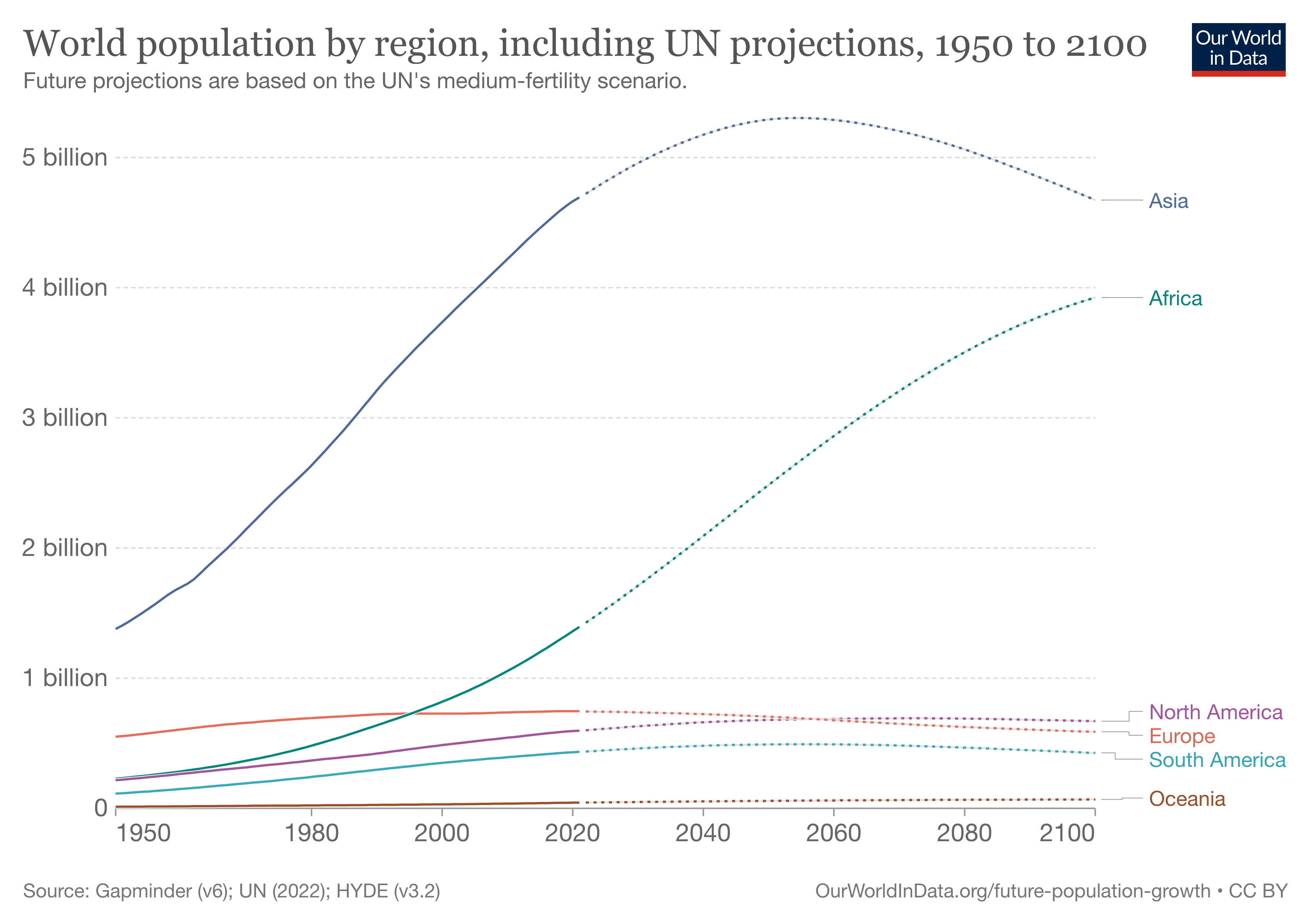
For Asia, the UN projects an increase only until the mid-21st century when population is projected to plateau around 5.3 billion. In the second half of the 21st century, the demographers foresee a decline of the Asian population to less than 5 billion by 2100.
Total population: WC-IIASA
This visualization shows in contrast the projections of the WC-IIASA researchers. Again the projected changes in the Americas, Oceania, and Europe are modest compared to changes in Africa and Asia.
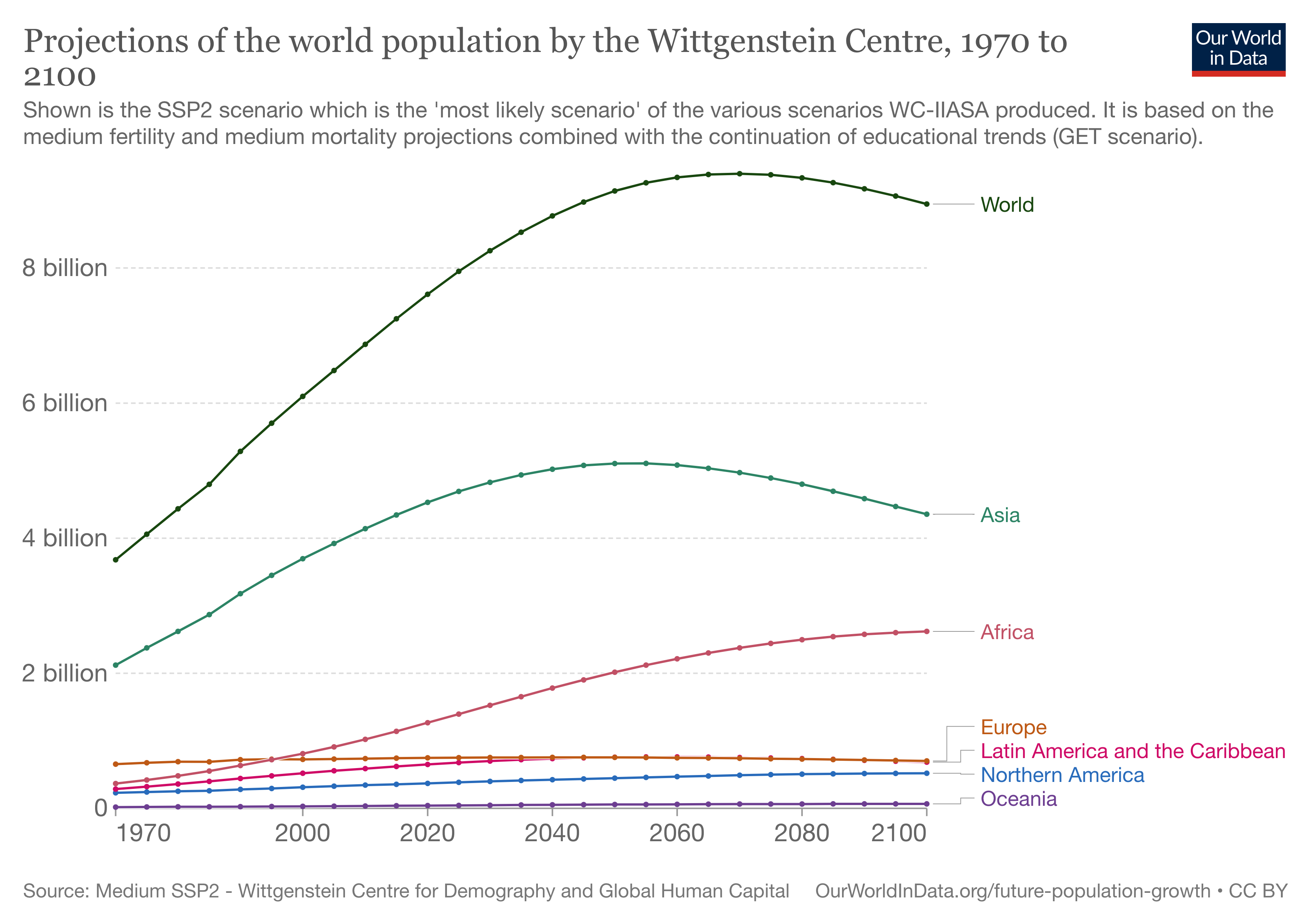
For Asia, this medium scenario by WC-IIASA projects an evolution that is very similar to the UN projection: The population will increase until the mid-21st century when the population plateaus (on a slightly lower level than in the UN projections) and then falls to well below 5 billion until the year 2100.
The big difference is Africa: While the UN projects that the population of Africa will increase 3.5-fold, the WC-IIASA researchers expect only a doubling. The demographers expect the African population to stay well below 3 billion, with population growth almost coming to a halt at the end of this century.
The projections by education scenario can be seen in this chart.
Fertility rate – UN vs IIASA-WC
As we have seen above, the crucial variable for how the world population will evolve is the total fertility rate: the number of children per woman. Let’s see how this crucial variable is projected to evolve.
There is some uncertainty about the level of the fertility rate today in some countries with poorer coverage of demographic statistics. This discrepancy in estimates today is also obvious in the comparison of the UN and WC-IIASA, where the UN mostly assumes that fertility rates today are higher than those assumed by WC-IIASA.
For the development over the next century however the changes over time are more fundamental. So let’s see what the projections of the UN and WC-IIASA entail.
Fertility rate: UN
The UN series shows that until 1966 women around the world had more than 5 children on average. Since then the fertility rate has halved and is now just below 2.5 children per woman. The UN projects that the fertility rate will further decline to 2.1 in 2070 and by the end of the century the fertility rate will fall below 2. A global fertility rate of 1.96 then would imply a decline of the global population over the long run.
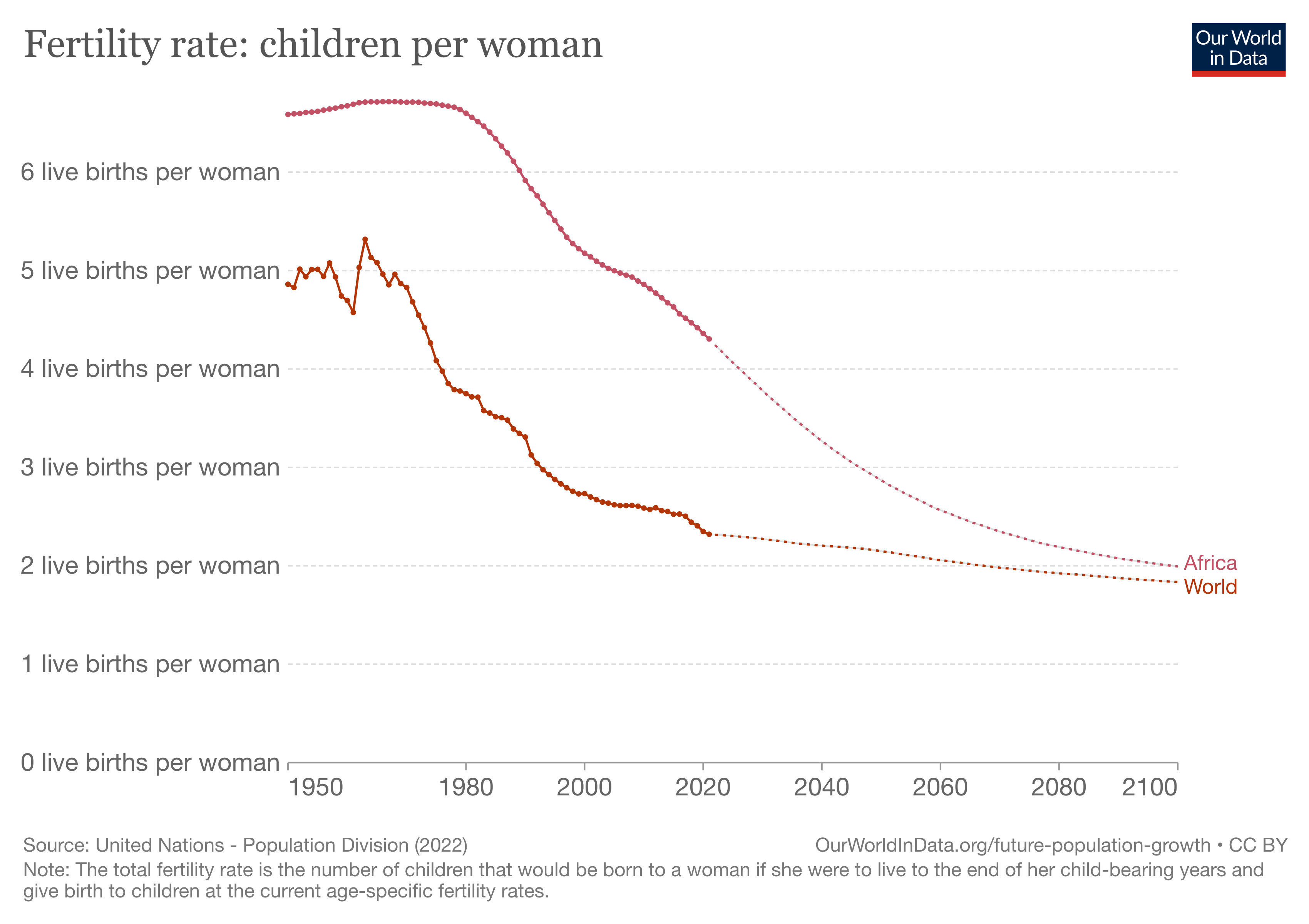
In Africa the fertility rate only fell below 5 in 2005 – four decades later than the global average. For the 21st century the UN Medium Variant projects a slow decline of the fertility rate in Africa to 2.1 children per woman until the end of the century.
Fertility rate: WC-IIASA
In their medium scenario – SSP2 with the GET assumptions on global education – the researchers project a much faster decline of the fertility rate than the UN. As early as the 2050s, the fertility rate will fall below 2 and by the end of the century will be 1.68 children per woman.
Africa too will reach a fertility rate below 2 by the 2070s under the medium assumptions.
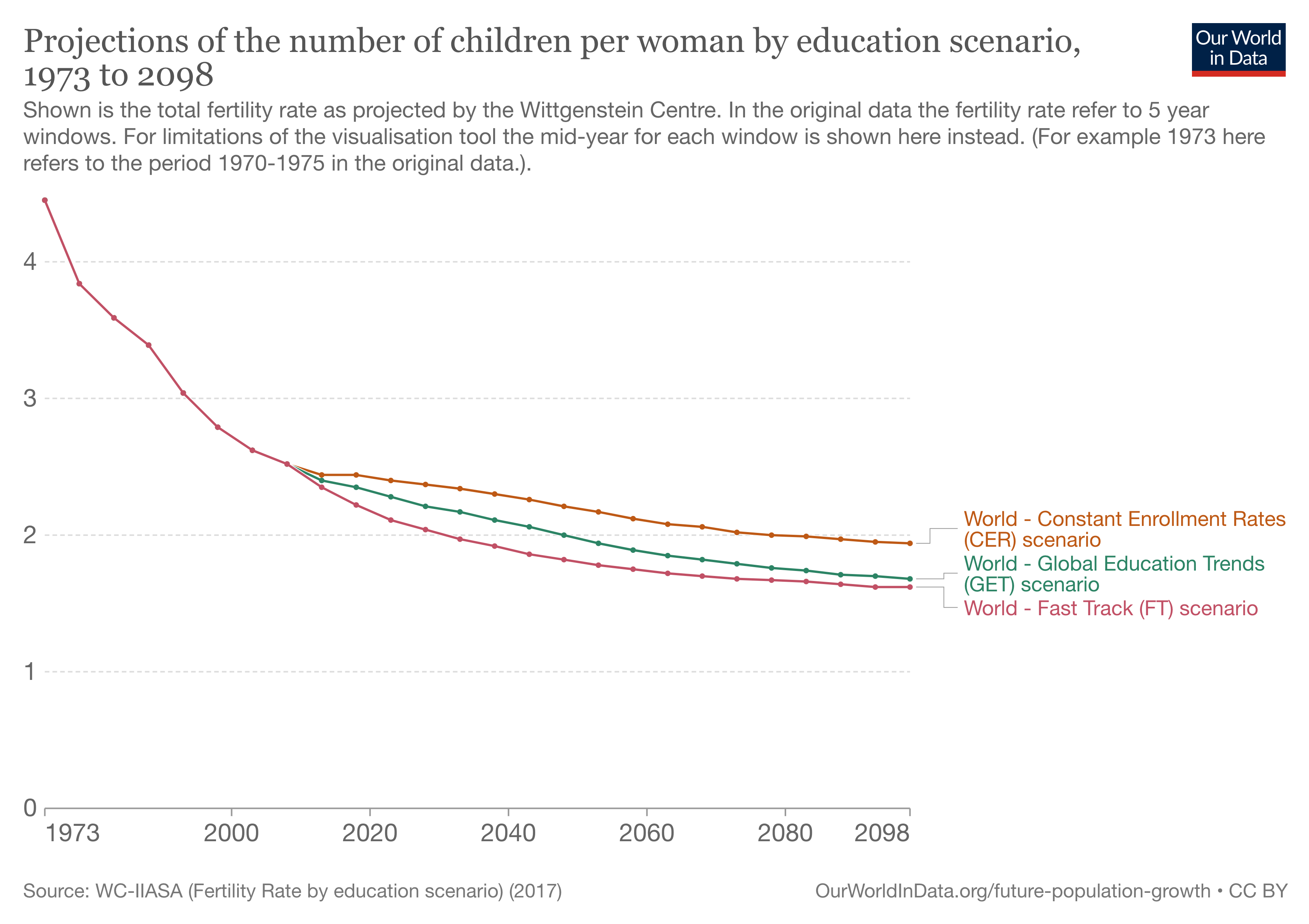
Interestingly the projections for the total fertility rate under the pessimistic Constant Enrollment Rates (CER) scenario are again very similar to the UN Medium projection. Under this scenario the WC-IIASA researchers project a global fertility rate just below 2 and a fertility rate for Africa just above 2. The pessimistic scenario of WC-IIASA is similar to the UN Medium projection, and all of the more optimistic WC-IIASA scenarios imply lower fertility rates. In these optimistic scenarios, the global population is therefore significantly smaller at the end of the century, with smaller cohorts of school-age children throughout this period.
In past decades UN demographers have been consistently too pessimistic in their projections of the global fertility rates as we show in our assessment of the past UN projections.
Population younger than 15: UN vs WC-IIASA
To see how the number of children in school age will evolve in different parts of the world, below we look at the population younger than 15 in all world regions separately and again compare the projections by the UN with those by WC-IIASA researchers.
Population younger than 15: UN
Shown below are the UN projections until the year 2100. Again, note the familiar picture of stagnating population sizes in Oceania, the Americas, and Europe. Due to the low fertility rates in Asia the UN projects a substantial decrease in the number of under-15-year-olds over the coming decades, falling from 1.1 billion today to 0.7 billion by 2100.

For Africa the UN projects an increase from 0.5 billion under-15-year-olds today to a peak of almost 1 billion in the 2090s when the number of children at school age is projected to start to decline.
Population younger than 15: WC-IIASA
Now let us compare this with the projection of the world population by world region according to the medium projection of WC-IIASA – the SSP2 scenario with the GET assumption on global educational improvements.
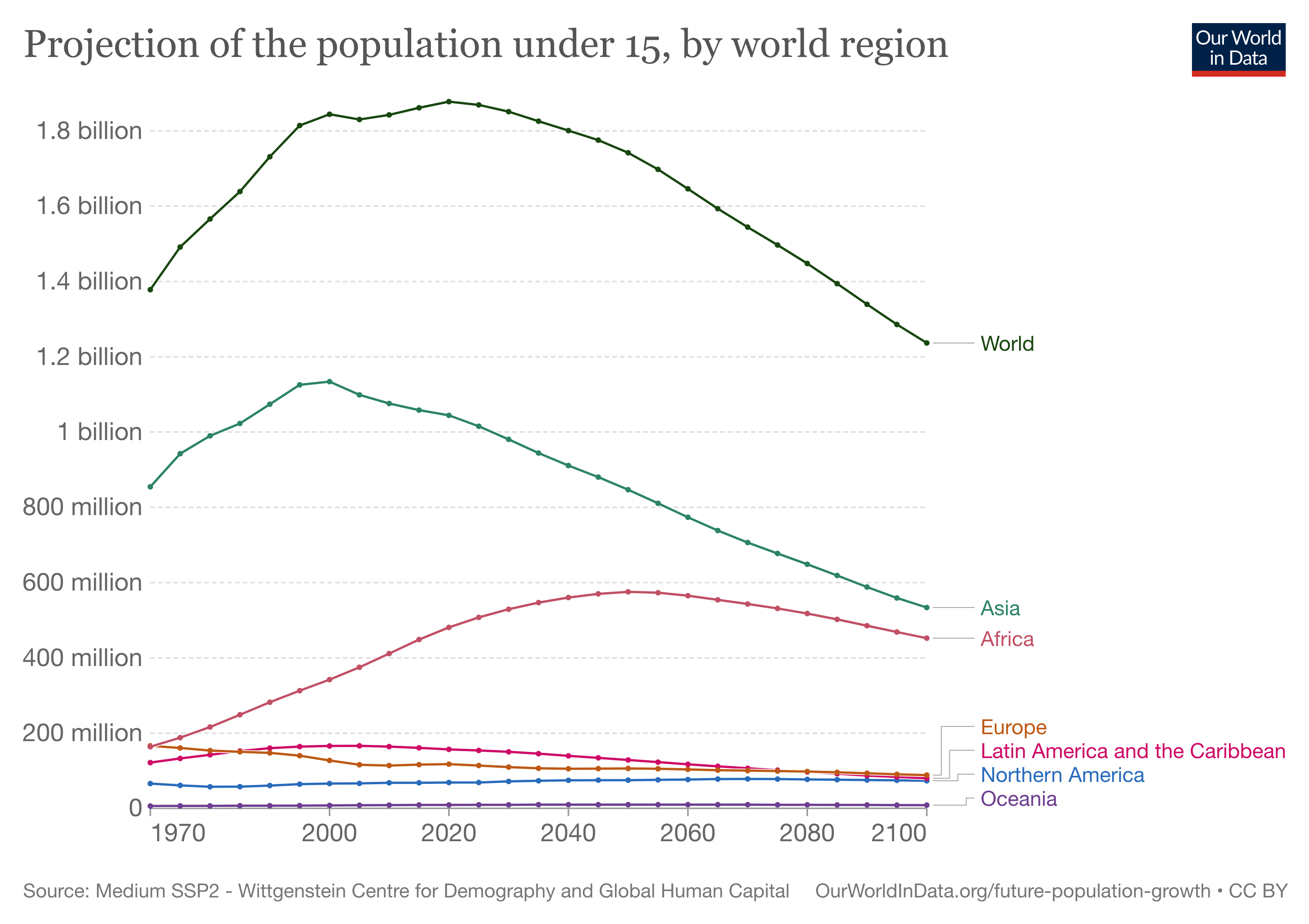
For Asia the researchers project an even more substantial decline to just over half a billion in the year 2100.
An even more substantial difference is projected for Africa where they project that the increase of the school-age population comes to an end below 600 million as early as 2050. By the end of the century the researchers expect a population of under-15-year-olds that is barely larger than today.
Africa is going to be crucial
What we have seen in the different projections of future global population is that future population growth in Africa is the most influential and contentious question. What happens in Africa now and in the coming decades will determine what size and structure the global population will have at the end of the century.18
There is considerable disagreement between UN and WC-IIASA projections. Even the medium projections vary significantly between the two institutions: The UN projects a population of 4.5 billion while WC-IIASA projects a population of only 2.6 billion. This difference of 2 billion is just as large as the difference between the projection for the global population by the UN (11.2 billion in 2100) and WC-IIASA (8.9 billion in 2100). Whether the world population increases to more than 10 billion will be decided by the speed with which Africa develops – especially how quickly women get access to better education, women’s opportunities within the job market, and how rapidly the improvements in child health continue.
This also matters significantly for some particular countries: For example, in Nigeria (currently a population of 190 million) the UN projects a population of 794 million at the end of the century. WC-IIASA, however, projects the population to be more than 25 percent smaller at 576 million.
Currently the total fertility rate in Africa still stands at 4.4 children per woman, according to the UN. It took 42 years (from 1972 to 2014) for global fertility to fall from 4.5 to 2.5 children. The UN projects that for Africa it will take longer than that – 56 years (from 2016 to 2072) – while the WC-IIASA researchers project a faster decline.

There are reasons to be optimistic that Africa could develop faster than the projections of the UN assume:
We know that falling mortality is associated with a decline of fertility. And health in Africa is improving rapidly:
– The child mortality rate in Africa has halved over the last two decades.
– HIV/AIDS is still a serious threat, but the epidemic is past its peak and the incidence rate in Sub-Saharan Africa has fallen by two thirds in the last 2 decades.
– Malaria too is in steep decline and the annual number of deaths has almost halved in just the last 15 years.
– Crucially, education has also changed substantially across Africa: The young generation is much better educated than older generations and the share of children out of school is falling rapidly.
– After decades of stagnation in many parts of Africa, economies across the continent are now growing and the share of the population in extreme poverty is now falling.
If you want to see more on how Africa is changing have a look at our slide show at AfricaInData.org.
Still, living conditions in most parts of the African continent are very poor and it would be too early to say that the changes that we are seeing now are foreshadowing the improvements which will lower fertility rates more rapidly. This will be determined only in the coming years, and the quantity and quality of education will be crucial as the visualization below shows. How quickly global population growth will slow will be decided by the chance of girls to go to school and the chances they have in life afterwards.
The world population by educational structure
What will be the result of these global demographic changes according to the WC-IIASA demographers? The middle scenario by WC-IIASA for the educational structure of the world population is shown in this chart here.
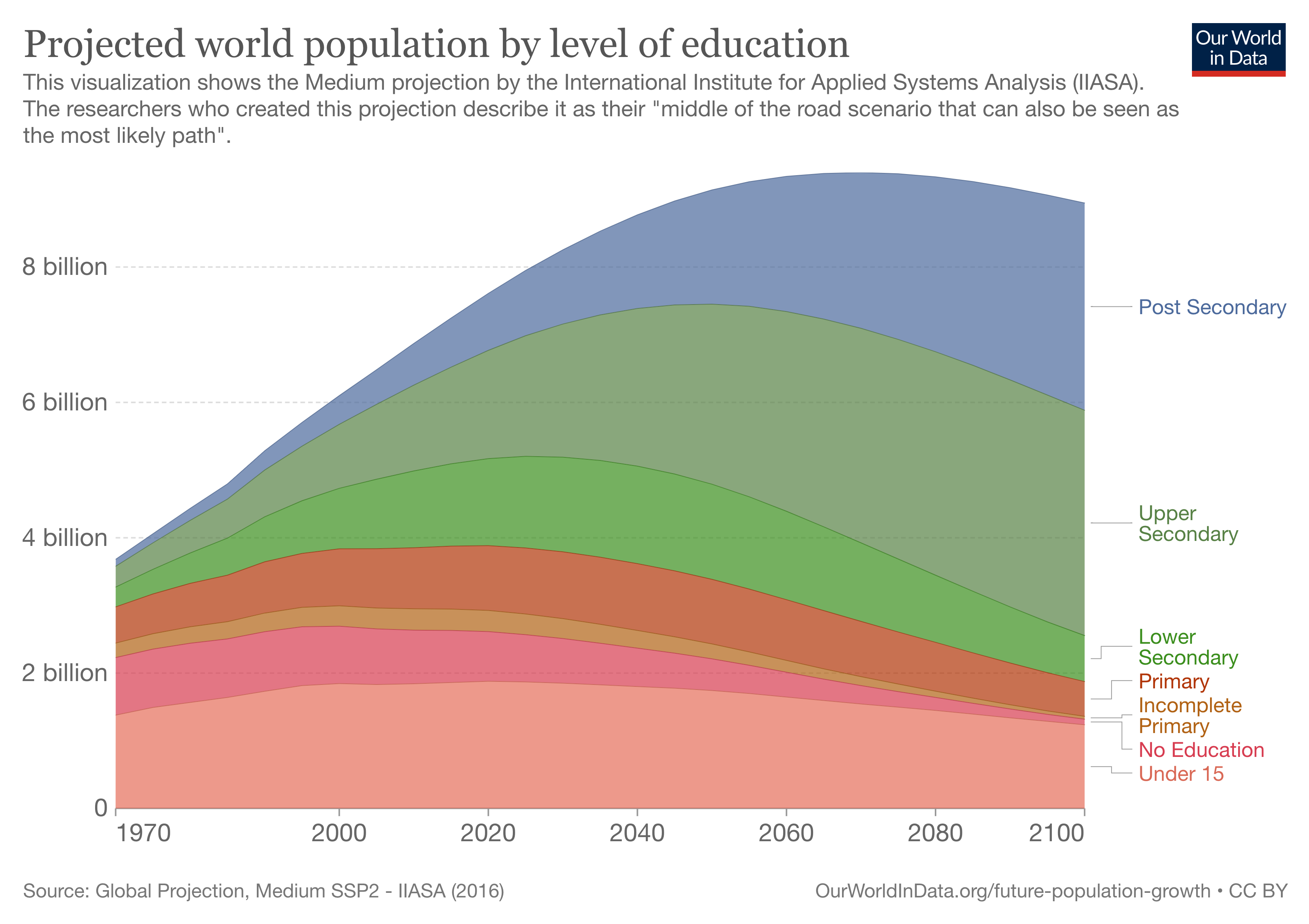
We already know that the future population will be better educated than today’s population because in the vast majority of countries the younger cohorts are much better educated than the older cohorts.19
The projection also shows that we will likely not see a rapid increase in the number of children in the world – we are likely not quite there yet, but the world is close to ‘peak child’.
‘Peak child’ is a historic turning point in global demographic history – after two centuries of rapid global population growth it will bring about the end of this era. And from the discussion of the various scenarios for the coming years we know that faster development – the access to education for women in particular and further improvements of child health are especially important – will mean that we are even closer to ‘peak child’.
Republished with permission of Our World In Data under a Creative Commons license. Read the original article.





